A couple of years ago a wrote a few posts about the emergence of metal cased military rockets as a weapon system in the early 1800s. In retrospect I made some hurried assessments, and after a while digging I’d like to revisit. The links to my older posts are below but I’ll repeat some of the story here for coherence. This is a story of terrorism, weapons technical intelligence, politics, subterfuge, tall tales and obfuscation, leading to financial success for one individual (William Congreve) that perhaps wasn’t entirely deserved. The traditional, commonly accepted wisdom was that Congreve “invented” rockets in about 1804, introducing “new” metal-bodied rockets, and also introducing larger calibre and longer range variants. He was supposedly “inspired” by the use rockets by Tipu Sultan in the Mysorean wars in India in the late 1700s. I think that is a misrepresentation (mostly by Congreve himself), of a much more interesting story which I’ll try to make here. I’ll also try to give credit for what I think Congreve deserved . I have been encouraged by a new colleague, a keen historian from India, Nidhin Olikara from Karnataka in India. Nidhin is involved in some exciting research in this area which I cannot reveal yet. Mr Olikara’s blog is here:
I’ll lay the story out chronologically as best I can:
- After being “invented” in China, rockets appeared first in Europe in the late 1300s and early 1400s. Rocketry was discussed in the book “Bellefortis” written in about 1405. However I think there is a red herring – the picture below, from Bellefortis, is quoted often as an image of a rocket. But I think it is not – to me it is simply a spear head, and the “rocket vent” is simply the socket for a spear. Some people quote the size of the man holding the rocket/spear but the other images within Bellefortis are massively inconsistent in scale too. I do accept however that Bellefortis does apparently discuss rockets elsewhere in text.
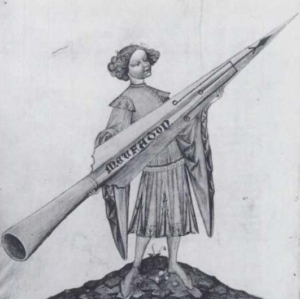 Rocket or spearhead with socket? I think the latter.
Rocket or spearhead with socket? I think the latter.
2. Throughout the 1500s and 1600s rockets were well known in Europe, mainly as a component of massively complex fireworks displays which became very popular in the late 1500s onwards. Leonardo da Vinci discussed rockets and a number of books about “pyrotechnics” were published. Some of the books clearly made the jump from rockets as a form of pyrotechnic entertainment, to rockets as a military weapon. In the 1500s rockets were clearly being developed by Conrad Haas (1529 -1569) in Austria/Hungary. Haas’s technology was surprisingly advanced, and included bell shaped nozzles and multi-stage systems.

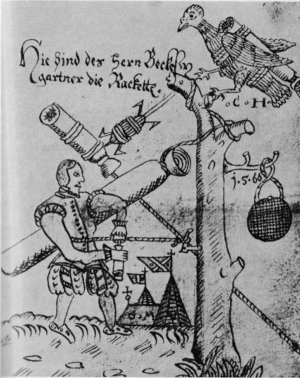
Note the venturis on the rockets and the engineer creating
a combustion chamber with a spike
3. Haas probably influenced a German, Johann Schmidlap who developed further the staged rockets in about 1561.

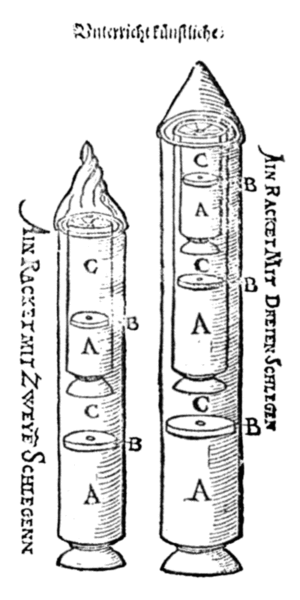
Double and triple stage rocket motors
4. In the late 1500s and early 1600s there were a number of experts publishing instructions on rocketry, these include the aforementioned Haas and Schmidlap, and others referred to by later authors as “Brechteltus”, Diagus Ulfanus, Adrian Roman, James Valhouse, Furtenbach and Frontsbergue. Many of these authors/experts developed their own formulae for the best dimensions of rockets in terms of diameter and length. Many also describe a very specific number of taps with a mallet of a specific weight for driving a needle into the packed rocket for the purposes of optimising the rocket motor ignition surface/chamber. This may seem an obscure instruction but is important. As far as I can tell these rockets were not metal cased but made from paper or card. In these early years of rocketry I understand that the propellant was standard blackpowder (gunpowder). As firearms developed over this period improvements were made to gunpowder to speed up its reaction. This made it rather too powerful for rockets with the pressure from the product gases being very high and the cardboard and paste cylinders could not contain the pressure so the tube ruptured. So rocket gunpowder was made by adding additional carbon (charcoal) which reduced its burn rate. This issue is fundamental to the development of rockets over the period – having a slow enough burn rate to not rupture the body of the rocket, but enough to project the rocket forward. Much trial and error went in to the development of effective geometry and hence design and production of the rocket motors. I have found some vague references to the military use of rockets against cavalry in 1600 but so far I have no detail.
5. A book was written by Jean Appier in about 1620, called La Pyrotechnie de Hanzelet Lorrain. Here’s an image of a simple rocket design from that book. Note the “warhead” with a fuse that is initiated as the rocket motor finally competes burning. Still there is no sign as yet of metal cased rockets. Note the combustion surface in the rear, created by tapping a mallet into the packed propellant.
 Note warhead initiation when motor finishes burn
Note warhead initiation when motor finishes burn
6. In 1635, and English book called Pyrotechnica by Robert Babington detailed rocket manufacture. These were not metal cased. Here’s a diagram of the mould used to create the rocket motor. Note the “needle” used to create the correct combustion geometry within the rocket’s gunpowder. Many of the documents and books discussed here recount how the needle is inserted into the packed gunpowder and gently knocked into place with a number of blows from a hammer. Basically the mould former on the left is lined with paper and card, filled with damp gunpowder, then the needle inserted and tapped into place and then dried. The needle is removed and the vent/nozzle formed (“choked”) with a twist of card held in place with string. This rocket is two and a half inches in diameter (which is a dimension that will be repeated in the future. Babington’s book is remarkably detailed. Babbington describes that the best paper to use for the body (“coffin”) of the rocket should be “old law books”! He then describes a range of explosive compositions and how to make them. The thrust of Babington’s book is entertaining firework displays – but it is fascinating how some of his more exotic pieces presage the use of sub-munitions. He also describes a range of test apparatus to allow the testing of gunpowder.
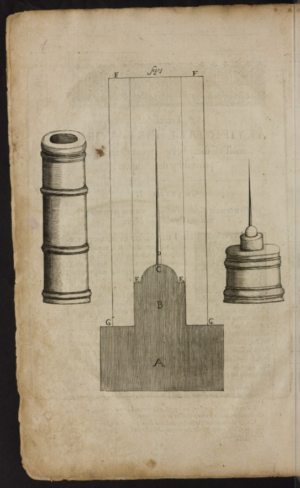 Rocket mold, cross section and needle for making combustion chamber.
Rocket mold, cross section and needle for making combustion chamber.
7. Another book “The Great Art of Artillery” by Kazimierz Siemienowicz published in 1650 also described a number of rocket systems. Again I can see no detail referencing metal cased rockets but there is considerable discussion about the variants of propellant mixes needed for various sizes of rockets. This document provides extremely detailed manufacturing instructions. (I am using an English translation published in 1729.) it is interesting to note that Siemienowicz comments about the habit of “pyrobolists” (those making rockets) to keep the methods of manufacturing very secret – but who let the secret out while drunk… Siemienowics describes rocket cases made from paper, pasteboard in some cases reinforces with wound thread and in some cases made from wood, with conical noses. The paper ones are described in some cases as being reinforced with iron wire, “for fear the powder would split it”. He does describe however a range of quite large rockets. Here’s a diagram of some of a range of Siemienowicz’s rockets. Note the Multiple rocket using 7 smaller rockets (unlike Elon Musk’s 9). Note also the range of payloads and multi staging. Siemienowcz is extremely detailed on various aspects of quality control.
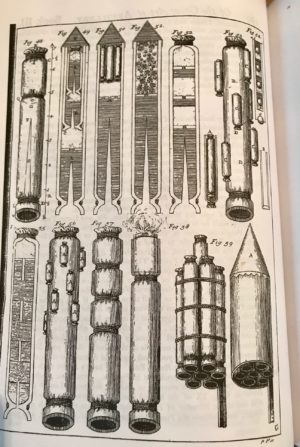
Siemienowicz’s advanced designs
Siemienowicz appears to be an admirable chemist, physicist and engineer. He spends pages decrying his predecessors who were closer to alchemists, who described their rocket making art in mystical forms hiding the secrets of their craft through pseudo-science. Siemienowicz developed some rules for rocket making and explains the science behind these rules:
First Rule: The larger the rocket the weaker and slower should the rocket propellant be (and vice versa, the smaller the rocket the faster burning propellant is required. This, he explains relates to the available surface area of the combusting propelllant’s hollow cone.
The second and third rules relate to the composition of the propellant in certain circumstances, adjusting the carbon, sulphur and saltpetre comparative quantities.
Siemienowicz describes rockets that are stabilised in flight with sticks and others stabilised by fins. He also describes a stabilisation method I have not come across before using a lead ball fastened to a piece of wire that trails to the rear of the rocket, which he says acts like a stick. Another technique he describes is to add lead filings at various points in the rocket motor – very sophisticated in concept, altering the movement of centres of gravity and thrust in a complex manner.
8. In 1696 Robert Anderson, and Englishman wrote a book with a clear rocket design, two and a half inches in diameter and about 18 inches long. In my earlier blogs I had misinterpreted some of the instructions from this book, assuming them to describe a metal cased rocket. After careful research and examination of this book I now no longer believe this to be the case, and my earlier assessment was an error. I think Anderson was using paper and pasteboard and not a metal cased body.
9. In the late 1700s , in the Mysorean wars in India with the British, the Army of Tipu Sultan used rockets extensively. Some of these were metal cased rockets (I think the first) and some of these rockets were recovered to England for analysis, at Woolwich Arsenal laboratory. The laboratory was under the control of William Congreve’s father. At the time William Congreve (junior) was not employed at Woolwich, he was busy as a publisher of a political magazine. So there were military metal-cased rockets in Woolwich some 20 years or so before Congreve is credited with their invention. I believe two of these metal cased Mysorean rockets are in a museum in the UK and I’ll be checking on this in coming weeks. My Indian friend Nidhin is investigating his excellent sources in India. I suspect that the crucial key here is the advanced metalsmithing available in Mysore at the time – often underestimated by Western historians – able to create a closed end lightweight metal cylinder, strong enough to contain the pressures of a rocket motor but light enough to not interfere significantly with flight.
10. In 1803 Robert Emmet’s uprising in Dublin used metal cased rockets (two and a half inches in diameter) against British forces, it is possible using the specific design and dimensions of Anderson’s rockets from 1696, or even Babbington’s from 1645. However rather than use paper or pasteboard, Emmet used a metal cased rocket. I’m not sure yet where this idea came from but it is possible it came from Robert Fulton, the American inventor whom he met in Paris in 1802. There is also a French connection to Mysore, and the French could also have recovered metal cased rockets from Mysore to Paris, and hence to Emmet. Certainly, reports suggest that Emmet came back from Paris with specific instructions on on how to construct rockets. Another possibility is that one of his workmen, Johnstone, had previously worked in India for the East India Company and had encountered the earlier metal cased rockets. There is a possibility that Emmet was using manufacturing instruction from one of a number of pyrotechnic books – many had similar instructions and statements suggest those instructions included tapping the rockets with needles to create combustion chambers. I believe some of Emmet’s rockets were recovered to the Ordnance laboratory at Woolwich, still under the control of Congreve’s father, in 1803. Again, this is just a few months before Congreve junior became employed by his father at Woolwich. So we know that there had been two sources of metal-cased rockets in Woolwich laboratory before William Congreve (Junior) even began his employment there, and it is very likely that Weapons technical intelligence activities and exploitation were undertaken by the laboratory.. There is also a very strong suggestion that one of Robert Emmet’s men, Pat Finerty, who had been employed by Emmet to make rockets for the Irish uprising was now taking the Kings shilling and was working in the laboratory at Woolwich, perhaps providing insight and experience. Perhaps he was a British spy in the first place.
11. In 1804, Congreve junior was struggling. His political publishing venture had gone bust and he needed work. But his father was a senior administrator for Woolwich Arsenal, and all of a sudden he had employment at Woolwich, and he also had potential access to political patronage – vitally important for raising money. The next few years saw Congreve develop and deploy military rockets. As a former editor of a political publication, Congreve knew the power of media and in parallel campaigned vigorously for funding and patronage to further develop military rockets. He even got himself awarded a commission as a Colonel and took charge of the rocket attack on Copenhagen and elsewhere, distrusting the military to deploy “his” invention. (In return they distrusted him and his lack of military experience). The development of Congreve’s rockets needs a whole different blog post (or book). But the point I am making here is this:
a. Congreve was a canny political operator, seeking patronage and funding.
b. Within the politics of the time, he understood that he would optimise his chances of patronage if he could take the entire credit for the development of militarily useful rockets.
c. Diluting the credit for the development with tales of Haider Ali or Tipu Sultan did not fit the politics of the time.
d. Nor indeed would giving the credit in any way to Irish rebels.
I also note that Congreve was an ardent patent producer – except when it came to rockets. was he concerned he might have been challenged?
So, Congreve has gone down in history as the “inventor” of military metal-cased rockets. but we can see that this was incorrect. We can also see that a wide variety of rocketry principles were developed by scientists and engineers in the two or three hundred years before 1804. What Congreve did do was this:
a. Management of a secret technical intelligence exploitation operation which reverse engineered both the Mysorean rockets and rockets from the Irish uprising.
b. Modern quality control and the development of robust and repeatable industrial processes- therefore enabling predictability of range etc.
c. The development of larger rockets with greater ranges and payloads, utilising the scientific knowledge of propellant technology at Woolwich.
d. The development (albeit by trial and error) of improved deployment and use operationally to improve effectiveness.
Congreve made much of the fact that an enemy capturing a Congreve rocket couldn’t reverse engineer it, and my assessment is that this could only be because of the chemistry of the propellant, which by the technology of the day could have been tested but not analysed chemically very well. I think the technical knowledge of the Woolwich Laboratory with regard to propellant science was crucial to the development of Congreve’s rockets.
In the future I hope that the work of Nidhin Olikara and his colleagues will shed more light on Mysorean rocket technology, and the pre-eminent role they had in the development of metal cased rockets, well before 1804.

Very interesting thank you. I hope you use the published data to amend the Wikipedia entry on Congreve to give reference to Emmett, which gets not even a mention (though Tipu does, extensively).